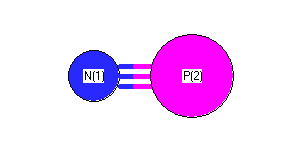Vibrational levels (cm-1) 
| Mode Number |
Symmetry |
Frequency |
Intensity |
Comment |
Description |
| Fundamental(cm-1) |
Harmonic(cm-1) |
Reference |
(km mol-1) |
unc. |
Reference |
| 1 |
Σ |
1323 |
1337 |
2007Iri:389 |
|
|
|
|
|
Detailed diatomic data
| ωe |
ωexe |
ωeye |
Be |
αe |
ZPE
| reference |
| 1336.948 |
6.8958 |
-0.00605 |
0.7864844 |
0.0055337 |
666.7872 |
2007Iri:389 |
vibrational zero-point energy: 661.6 cm
-1 (from fundamental vibrations)
Calculated vibrational frequencies for
PN
+ (phosphorus nitride cation).
More spectroscopic constants are available at the NIST Physics Laboratory website:
Geometric Data

Point Group C∞v
Internal coordinates
distances (r) in Å, angles (a) in degrees, dihedrals (d) in degrees
| Description |
Value |
unc. |
Connectivity |
Reference |
Comment |
| Atom 1 |
Atom 2 |
Atom 3 |
Atom 4 |
| rPN |
1.491 |
|
1 |
2 |
|
|
1979HUB/HER |
re |
Cartesians
| Atom |
x (Å) |
y (Å) |
z (Å) |
| N1 |
0.0000 |
0.0000 |
1.4909 |
| P2 |
0.0000 |
0.0000 |
0.0000 |
Atom - Atom Distances 
Distances in Å
| |
N1 |
P2 |
| N1 |
|
1.4909 |
| P2 |
1.4909 |
|
Calculated geometries
for PN
+ (phosphorus nitride cation).
Bond descriptions
Examples: C-C single bond, C=C, double bond, C#C triple bond, C:C aromatic bond
Connectivity
Dipole, Quadrupole and Polarizability
Electric dipole moment 
| State |
Config |
State description |
Conf description |
Exp. min. |
Dipole (Debye) |
Reference |
comment |
Point Group |
Components |
| x |
y |
z |
total |
dipole |
quadrupole |
| 1 |
1 |
1Σ |
C∞v |
True |
|
|
2.751 |
2.751 |
NISTdiatomic |
MW +-0.0008 μe |
C∞v |
1 |
1 |
Experimental dipole measurement abbreviations: MW microwave; DT Dielectric with Temperature variation; DR Indirect (usually an upper limit); MB Molecular beam
Calculated electric dipole moments for
PN
+ (phosphorus nitride cation).
Vibration specific dipole moments
Electric quadrupole moment 
| State |
Config |
State description |
Conf description |
Exp. min. |
Quadrupole (D Å) |
Reference |
comment |
Point Group |
Components |
| xx |
yy |
zz |
dipole |
quadrupole |
| 1 |
1 |
1Σ |
C∞v |
True |
|
|
|
|
|
C∞v |
1 |
1 |
Calculated electric quadrupole moments for
PN
+ (phosphorus nitride cation).










